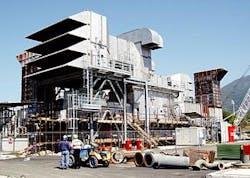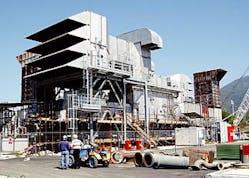Three large refrigerating compressors for the barge-mounted process plant at Statoil's gas liquefaction facility on Melkøya in northern Norway were finally ready for delivery early last month, nearly 6 months late, said a company statement.
The compressors play a key role in the process of cooling natural gas from the Snøhvit field in the Barents Sea to liquefaction temperatures, according to Statoil. What impact the 6-month delay will have on completing the plant assembly job at Dragados Offshore's yard in Cadiz, however, remains to be seen, said the company. The Melkøya facility to liquefy Snøhvit gas is due to come on line at the same time as natural production begins from the Barents Sea field in 2006.
Modification delays
Tests during May, said Statoil, showed that the compressors needed to be modified if they were to meet specifications for performance and operating range. Statoil then appointed a group of specialists to assist the project organization in solving these problems.
null
Subsequent modifications have proven successful, said the company; results from testing the third and final compressor were approved on Aug. 31.
Arne Grislingås, speaking on behalf of Statoil's representatives in the specialist group, admitted, however, that these units "don't fully satisfy our original performance specifications." The deviations are small, however, and "will have a limited impact on plant operation."
Nils-Bjørn Jordal, Statoil's project director for the Melkøya plant, said in early September that it was too early to say anything about the consequences of the considerable delay in delivering the compressors.
"Receiving these units almost 6 months behind the original schedule will have a knock-on effect in completing the process plant. We're doing what we can to recover the delays, but we'll clearly have to transfer work from Cadiz to Melkøya."
Generators, refrigerating compressors
The gas liquefaction plant at Melkøya is designed to be self-sufficient for power under normal operation.
This electricity will come from dedicated generator sets developed and constructed by Italy's GE Nuovo Pignone, which has also produced the plant's refrigerating compressors (Fig. 1). Siemens AG of Germany delivered the frequency-controlled electrical motors to drive the compressors.
Generators and compressors will be installed in the barge-mounted process plant under assembly at the Dragados Cadiz yard. This unit is due in turn to be shipped to Melkøya in summer 2005. Five generators will be installed on the far right of the barge-mounted process plant. The main component in each of the five generator packages for Melkøya is a turbine fuelled by natural gas drawn from the Snøhvit production flow (Fig. 2).
This in turn drives a generator to produce electricity. The five packages have a combined capacity of about 230 Mw, says Statoil.
LNG can also be used as fuel for the turbines if production from the Barents Sea field must be shut down, according to the company.
Each turbine is an industrialized version of the aircraft jet engine found on such equipment as the Boeing 747, says the company: "This is a very energy-efficient model and has been equipped with burners which ensure low emissions of nitrogen oxides."
The main consumer for the electricity provided by the gas liquefaction plant's five generating sets will be the three large refrigerating compressors.
These compressors compress the coolant-gas circulated in a closed circuit, roughly like a domestic refrigerator, says the company. "This coolant is refrigerated and condensed before being depressurized, which in turn vaporizes it to create the required drop in temperature." That in turn cools the Snøhvit gas to liquification.
The three compressors occupy separate cooling circuits in the liquefaction process, covering pre-cooling, liquefaction, and subcooling, respectively.
Driver capacity for the pre and sub-cooling compressor trains is 65 Mw apiece, the largest electrical motors at any Statoil plant, says the company. Capacity for the liquefaction train is 32 Mw.
While the gas turbines generate power to drive the refrigerating compressors, the heat they give off warms the hot oil used in the liquefaction process.



